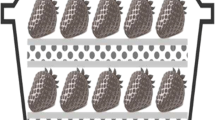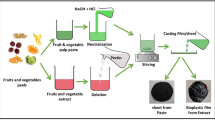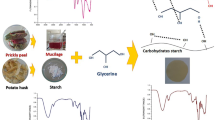Abstract
Biodegradable films based on persimmon (Diospyros kaki L.) with glycerol and pectin were developed, characterized, and applied as a lid for bowls with minimally processed vegetables (MPV) (cucumber, carrot, and beetroot), with PVC as a positive control. Microbiological and physical parameters of MPV were investigated during refrigerated storage. The films presented high values of water vapor permeability (WVP) (5.77–6.63 × 10−6 g h−1 m−1 Pa−1) and water solubility (WS) (68.80–80.86 %) and 0.75–1.35 MPa, 17.71–20.55%, and 3.82–10.06 MPa of tensile strength (TS), elongation at break (EB), and Young’s modulus (YM), respectively. The addition of glycerol and pectin decreased TS and increased YM, EB, and WS of films. Thermogravimetric analysis showed two important steps of degradation related to glycerol, polymer backbone, pectin, and monosaccharide ring: 205 and 335 °C. Scanning electron microscopy revealed a homogenous microstructure of the films. The film with lower WVP and thickness, higher TS, good flexibility, and a more vivid color was selected as a lid for MPV bowls. Vegetables covered with film or PVC presented similar results regarding thermotolerant coliform evolution (< 3 to 160 MPN g−1); psychrophiles and fungi count (< 2 to 8.72 log CFU g−1); pH value (5.95 to 6.18 for cucumber; 5.96 to 6.10 for carrot; 6.02 to 5.75 for beetroot); and optical properties. Persimmon film reduced the dehydration process of MPV, though to a lower extent than PVC. This study indicates the potential of persimmon-based film as an alternative to synthetic lids for vegetable packaging.






Similar content being viewed by others
References
Al-Juhaimi, F., Ghafoor, K., & Babiker, E. E. (2012). Effect of gum arabic edible coating on weight loss, firmness and sensory characteristics of cucumber (Cucumis sativus L.) fruit during storage. Pakistan Journal of Botany, 44(4), 1439–1444.
American public health association. (2015). Compendium of methods for the microbiological examination of foods. Washington: APHA. https://doi.org/10.2105/MBEF.0222.
Andrade, R. M. S., Ferreira, M. S. L., & Gonçalves, É. C. B. A. (2016). Development and characterization of edible films based on fruit and vegetable residues: development of edible films based on residues. Journal of Food Science, 81(2), E412–E418. https://doi.org/10.1111/1750-3841.13192.
AOAC. (2000). Association of official analytical chemistry official methods of analysis (16th ed.). Gaithersburg: AOAC International.
Arquelau, P. B. d. F., Silva, V. D. M., Garcia, M. A. V. T., de Araújo, R. L., & Fante, C. A. (2019). Characterization of edible coatings based on ripe “Prata” banana peel flour. Food Hydrocolloids, 89, 570–578. https://doi.org/10.1016/j.foodhyd.2018.11.029.
ASTMD882. (1995). Test method for tensile properties of thin plastic sheeting. ASTM International. https://doi.org/10.1520/D0882-12
Azeredo, H. M. C., Miranda, K. W. E., Rosa, M. F., Nascimento, D. M., & de Moura, M. R. (2012). Edible films from alginate-acerola puree reinforced with cellulose whiskers. LWT - Food Science and Technology, 46(1), 294–297. https://doi.org/10.1016/j.lwt.2011.09.016.
Basiak, E., Lenart, A., & Debeaufort, F. (2018). How glycerol and water contents affect the structural and functional properties of starch-based edible films. Polymers, 10(4), 412. https://doi.org/10.3390/polym10040412.
Becaro, A. A., Puti, F. C., Panosso, A. R., Gern, J. C., Brandão, H. M., Correa, D. S., & Ferreira, M. D. (2016). Postharvest quality of fresh-cut carrots packaged in plastic films containing silver nanoparticles. Food and Bioprocess Technology, 9(4), 637–649. https://doi.org/10.1007/s11947-015-1656-z.
BRASIL (2001) Ministério da saúde, Agência Nacional de Vigilância Sanitária (ANVISA), no Resolução RDC no 12 de 02 de janeiro de 2001, Agência Nacional de Vigilância Sanitária (ANVISA), 37. http://bvsms.saude.gov.br/bvs/saudelegis/anvisa/2001/res0012_02_01_2001.html. Accessed 2 Oct 2020
Cao, L., Liu, W., & Wang, L. (2018). Developing a green and edible film from Cassia gum: the effects of glycerol and sorbitol. Journal of Cleaner Production, 175, 276–282. https://doi.org/10.1016/j.jclepro.2017.12.064.
Capitani, M. I., Matus-Basto, A., Ruiz-Ruiz, J. C., Santiago-García, J. L., Betancur-Ancona, D. A., Nolasco, S. M., Tomás, M. C., & Segura-Campos, M. R. (2016). Characterization of biodegradable films based on Salvia hispanica L. protein and mucilage. Food and Bioprocess Technology, 9(8), 1276–1286. https://doi.org/10.1007/s11947-016-1717-y.
Cisneros-Zevallos, L., Saltveit, M. E., & Krochta, J. M. (1997). Hygroscopic Coatings Control Surface White Discoloration of Peeled (Minimally Processed) Carrots During Storage. Journal of Food Science, 62(2), 363–399.
Comaposada, J., Marcos, B., Bou, R., & Gou, P. (2018). Influence of surfactants and proteins on the properties of wet edible calcium alginate meat coatings. Food Research International, 108, 539–550. https://doi.org/10.1016/j.foodres.2018.04.002.
Condurso, C., Cincotta, F., Tripodi, G., Merlino, M., Giarratana, F., & Verzera, A. (2020). A new approach for the shelf-life definition of minimally processed carrots. Postharvest Biology and Technology, 163, 111–138. https://doi.org/10.1016/j.postharvbio.2020.111138.
Conesa, C., Laguarda‑Miró, N., Fito, P., & Seguí, L. (2019). Evaluation of persimmon (Diospyros kaki Thunb. ‘Rojo Brillante’) industrial residue as a source for value added products. Waste and biomass valorization, 1, 1–12. https://doi.org/10.1007/s12649-019-00621-0.
Crizel, T. M., Rios, A. O., Alves, V. D., Bandarra, N., Moldão-Martins, M., & Flôres, S. H. (2018). Biodegradable films based on gelatin and papaya peel microparticles with antioxidant properties. Food and Bioprocess Technology, 11(3), 536–550. https://doi.org/10.1007/s11947-017-2030-0.
De Barros-Alexandrino, T. T., Tosi, M. M., & Assis, O. B. G. (2019). Comparison between chitosan nanoparticles and cellulose nanofibers as reinforcement fillers in papaya puree films: effects on mechanical, water vapor barrier, and thermal properties: papay films with reinforcing nanofillers. Polymer Engineering & Science, 59(S1), E287–E292. https://doi.org/10.1002/pen.24938.
De Brito Nogueira, T. B., da Silva, T. P. M., de Araújo Luiz, D., de Andrade, C. J., de Andrade, L. M., Ferreira, M. S. L., & Fai, A. E. C. (2020). Fruits and vegetable-processing waste: a case study in two markets at Rio de Janeiro, RJ, Brazil. Environmental Science and Pollution Research, 27(15), 18530–18540. https://doi.org/10.1007/s11356-020-08244-y.
De Corato, U., & Cancellara, F. A. (2019). Measures, technologies, and incentives for cleaning the minimally processed fruits and vegetables supply chain in the Italian food industry. Journal of Cleaner Production, 237, 117735. https://doi.org/10.1016/j.jclepro.2019.117735.
Du, W.-X., Olsen, C. W., Avena-Bustillos, R. J., McHugh, T. H., Levin, C. E., & Friedman, M. (2008). Antibacterial activity against E. coli O157:H7, physical properties, and storage stability of novel carvacrol-containing edible tomato films. Journal of Food Science, 73(7), M378–M383. https://doi.org/10.1111/j.1750-3841.2008.00892.x.
Espino-Díaz, M., De Jesús Ornelas-Paz, J., Martínez-Téllez, M. A., Santillán, C., Barbosa-Cánovas, G. V., Zamudio-Flores, P. B., & Olivas, G. I. (2010). Development and characterization of edible films based on mucilage of Opuntia ficus-indica (L.). Journal of Food Science, 75(6), E347–E352. https://doi.org/10.1111/j.1750-3841.2010.01661.x.
Espitia, P. J. P., Avena-Bustillos, R. J., Du, W.-X., Teófilo, R. F., Soares, N. F. F., & McHugh, T. H. (2014). Optimal antimicrobial formulation and physical–mechanical properties of edible films based on açaí and pectin for food preservation. Food Packaging and Shelf Life, 2(1), 38–49. https://doi.org/10.1016/j.fpsl.2014.06.002.
Fai, A. E. C., Alves de Souza, M. R., de Barros, S. T., Bruno, N. V., Ferreira, M. S. L., & de A Gonçalves, É. C. B. (2016). Development and evaluation of biodegradable films and coatings obtained from fruit and vegetable residues applied to fresh-cut carrot (Daucus carota L.). Postharvest Biology and Technology, 112, 194–204. https://doi.org/10.1016/j.postharvbio.2015.09.021.
Fakhouri, F. M., Martelli, S. M., Caon, T., Velasco, J. I., & Mei, L. H. I. (2015). Edible films and coatings based on starch/gelatin: film properties and effect of coatings on quality of refrigerated Red Crimson grapes. Postharvest Biology and Technology, 109, 57–64. https://doi.org/10.1016/j.postharvbio.2015.05.015.
Ferreira, M. S., Fai, A. E. C., Andrade, C. T., Picciani, P. H., Azero, E. G., & Gonçalves, É. C. (2016). Edible films and coatings based on biodegradable residues applied to acerolas ( Malpighia punicifolia L.): biodegradable coatings applied to acerolas. Journal of the Science of Food and Agriculture, 96(5), 1634–1642. https://doi.org/10.1002/jsfa.7265.
Giordani, E., Doucette, S., Nin, S., & Del Bubba, M. (2011). Selected primary and secondary metabolites in fresh persimmon (Diospyros Kaki Thunb.): a review of analytical methods and current knowledge of fruit composition and health benefits. Food Research International, 44(7), 1752–1767. https://doi.org/10.1016/j.foodres.2011.01.036.
Gonçalves, S. M., dos Santos, D. C., Motta, J. F. G., dos Santos, R. R., Chávez, D. W. H., & de Melo, N. R. (2019). Structure and functional properties of cellulose acetate films incorporated with glycerol. Carbohydrate Polymers, 209, 190–197. https://doi.org/10.1016/j.carbpol.2019.01.031.
Goyeneche, R., Roura, S., & Di Scala, K. (2014). Principal component and hierarchical cluster analysis to select hurdle technologies for minimal processed radishes. LWT - Food Science and Technology, 57(2), 522–529. https://doi.org/10.1016/j.lwt.2014.02.022.
Hajji, S., Younes, I., Affes, S., Boufi, S., & Nasri, M. (2018). Optimization of the formulation of chitosan edible coatings supplemented with carotenoproteins and their use for extending strawberries postharvest life. Food Hydrocolloids, 83, 375–392. https://doi.org/10.1016/j.foodhyd.2018.05.013.
Hernández-Carrión, M., Vázquez-Gutiérrez, J. L., Hernando, I., & Quiles, A. (2014). Impact of high hydrostatic pressure and pasteurization on the structure and the extractability of bioactive compounds of persimmon “Rojo Brillante”. Journal of Food Science, 79(1), 32–38. https://doi.org/10.1111/1750-3841.12321.
Hernández-Muñoz, P., Almenar, E., Ocio, M. J., & Gavara, R. (2006). Effect of calcium dips and chitosan coatings on postharvest life of strawberries (Fragaria x ananassa). Postharvest Biology and Technology, 39(3), 247–253. https://doi.org/10.1016/j.postharvbio.2005.11.006.
Hussein, Z., Caleb, O. J., & Opara, U. L. (2015). Perforation-mediated modified atmosphere packaging of fresh and minimally processed produce—a review. Food Packaging and Shelf Life, 6, 7–20. https://doi.org/10.1016/j.fpsl.2015.08.003.
Jirukkakul, N. (2016). The study of edible film production from unriped banana flour and riped banana puree. International Food Research Journal, 23(1), 95–101.
Kadzińska, J., Bryś, J., Ostrowska-Ligęza, E., Estéve, M., & Janowicz, M. (2019). Influence of vegetable oils addition on the selected physical properties of apple–sodium alginate edible films. Polymer Bulletin., 77, 883–900. https://doi.org/10.1007/s00289-019-02777-0.
Kaewprachu, P., & Rawdkuen, S. (2016). Application of active edible film as food packaging for food preservation and extending shelf life. In N. Garg, S. M. Abdel-Aziz, & A. Aeron (Orgs.) (Eds.), Microbes in Food and Health (pp. 185–205). Springer International Publishing. https://doi.org/10.1007/978-3-319-25277-3_10.
Kaewprachu, P., Osako, K., Benjakul, S., & Rawdkuen, S. (2016). Effect of protein concentrations on the properties of fish myofibrillar protein based film compared with PVC film. Journal of Food Science and Technology, 53(4), 2083–2091. https://doi.org/10.1007/s13197-016-2170-7.
Kim, S., Kang, J., & Song, K. B. (2020). Development of a sword bean (Canavalia gladiata) starch film containing goji berry extract. Food and Bioprocess Technology, 13(5), 911–921. https://doi.org/10.1007/s11947-020-02447-4.
Leceta, I., Molinaro, S., Guerrero, P., Kerry, J. P., & de la Caba, K. (2015). Quality attributes of map packaged ready-to-eat baby carrots by using chitosan-based coatings. Postharvest Biology and Technology, 100, 142–150. https://doi.org/10.1016/j.postharvbio.2014.09.022.
Liu, H., Adhikari, R., Guo, Q., & Adhikari, B. (2013). Preparation and characterization of glycerol plasticized (high-amylose) starch–chitosan films. Journal of Food Engineering, 116(2), 588–597. https://doi.org/10.1016/j.jfoodeng.2012.12.037.
Lucera, A., Costa, C., Mastromatteo, M., Conte, A., & Del Nobile, M. A. (2010). Influence of different packaging systems on fresh-cut zucchini (Cucurbita pepo). Innovative Food Science & Emerging Technologies, 11(2), 361–368. https://doi.org/10.1016/j.ifset.2009.08.002.
Martelli, M. R., Barros, T. T., de Moura, M. R., Mattoso, L. H. C., & Assis, O. B. G. (2013). Effect of chitosan nanoparticles and pectin content on mechanical properties and water vapor permeability of banana puree films. Journal of Food Science, 78(1), N98–N104. https://doi.org/10.1111/j.1750-3841.2012.03006.x.
Matheus, J. R. V., de Andrade, C. J., Miyahira, R. F., & Fai, A. E. C. (2020). Persimmon (Diospyros Kaki L.): chemical properties, bioactive compounds and potential use in the development of new products – a review. Food Reviews International, 1–18. https://doi.org/10.1080/87559129.2020.1733597.
Moliner, C., Aguilar, K., Bosio, B., Arato, E., & Ribes, A. (2016). Thermo-oxidative characterisation of the residues from persimmon harvest for its use in energy recovery processes. Fuel Processing Technology, 152, 421–429. https://doi.org/10.1016/j.fuproc.2016.07.008.
Nanda, S., Isen, J., Dalai, A. K., & Kozinski, J. A. (2016). Gasification of fruit wastes and agro-food residues in supercritical water. Energy Conversion and Management, 110, 296–306. https://doi.org/10.1016/j.enconman.2015.11.060.
Nouraddini, M., Esmaiili, M., & Mohtarami, F. (2018). Development and characterization of edible films based on eggplant flour and corn starch. International Journal of Biological Macromolecules, 120(Pt B), 1639–1645. https://doi.org/10.1016/j.ijbiomac.2018.09.126.
Ojagh, S. M., Rezaei, M., Razavi, S. H., & Hosseini, S. M. H. (2010). Development and evaluation of a novel biodegradable film made from chitosan and cinnamon essential oil with low affinity toward water. Food Chemistry, 122(1), 161–166. https://doi.org/10.1016/j.foodchem.2010.02.033.
Olawuyi, I. F., Park, J. J., Lee, J. J., & Lee, W. Y. (2019). Combined effect of chitosan coating and modified atmosphere packaging on fresh-cut cucumber. Food Science & Nutrition, 7(3), 1043–1052. https://doi.org/10.1002/fsn3.937.
Orsuwan, A., & Sothornvit, R. (2018). Active banana flour nanocomposite films incorporated with garlic essential oil as multifunctional packaging material for food application. Food and Bioprocess Technology, 11(6), 1199–1210. https://doi.org/10.1007/s11947-018-2089-2.
Patel, C., & Panigrahi, J. (2019). Starch glucose coating-induced postharvest shelf-life extension of cucumber. Food Chemistry, 288, 208–214. https://doi.org/10.1016/j.foodchem.2019.02.123.
Persic, M., Jakopic, J., & Hudina, M. (2018). The effect of post-harvest technologies on selected metabolites in persimmon (Diospyros Kaki Thunb.) fruit. Journal of the Science of Food and Agriculture, 99(2), 854–860. https://doi.org/10.1002/jsfa.9255.
Rangel-Marrón, M., Mani-López, E., Palou, E., & López-Malo, A. (2019). Effects of alginate-glycerol-citric acid concentrations on selected physical, mechanical, and barrier properties of papaya puree-based edible films and coatings, as evaluated by response surface methodology. LWT, 101, 83–91. https://doi.org/10.1016/j.lwt.2018.11.005.
Reis, L. C. B., Souza, C. O., da Silva, J. B. A., Martins, A. C., Nunes, I. L., & Druzian, J. I. (2015). Active biocomposites of cassava starch: the effect of yerba mate extract and mango pulp as antioxidant additives on the properties and the stability of a packaged product. Food and Bioproducts Processing, 94, 382–391. https://doi.org/10.1016/j.fbp.2014.05.004.
Robles-Flores, G. D. C., Abud-Archila, M., Ventura-Canseco, L. M. C., Meza-Gordillo, R., Grajales-Lagunes, A., Ruiz-Cabrera, M. A., & Gutiérrez-Miceli, F. A. (2018). Development and evaluation of a film and edible coating obtained from the cajanus cajan seed applied to fresh strawberry fruit. Food and Bioprocess Technology, 11(12), 2172–2181. https://doi.org/10.1007/s11947-018-2175-5.
Rocha Plácido Moore, G., Maria Martelli, S., Gandolfo, C., & José do Amaral Sobral, P., & Borges Laurindo, J. (2006). Influence of the glycerol concentration on some physical properties of feather keratin films. Food Hydrocolloids, 20(7), 975–982. https://doi.org/10.1016/j.foodhyd.2005.11.001.
Rojas-Bravo, M., Rojas-Zenteno, E. G., Hernández-Carranza, P., Ávila-Sosa, R., Aguilar-Sánchez, R., Ruiz-López, I. I., & Ochoa-Velasco, C. E. (2019). A potential application of mango (Mangifera indica L. cv Manila) peel powder to increase the total phenolic compounds and antioxidant capacity of edible films and coatings. Food and Bioprocess Technology, 12(9), 1584–1592. https://doi.org/10.1007/s11947-019-02317-8.
Sentandreu, E., Cerdán-Calero, M., & Navarro, J. L. (2015). Metabolite profiling of pigments from acid-hydrolysed persimmon (Diospyros Kaki) extracts by HPLC-DAD/ESI-MSn analysis. Journal of Food Composition and Analysis, 38, 55–61. https://doi.org/10.1016/j.jfca.2014.10.010.
Senturk Parreidt, T., Schott, M., Schmid, M., & Müller, K. (2018). Effect of presence and concentration of plasticizers, vegetable oils, and surfactants on the properties of sodium-alginate-based edible coatings. International Journal of Molecular Sciences, 19(3), 742. https://doi.org/10.3390/ijms19030742.
Seslija, S., Nešić, A., Ružić, J., Krušić, M. K., Veličković, S., Avolio, R., et al. (2018). Edible blend films of pectin and poly(ethylene glycol): Preparation and physico-chemical evaluation. Food Hydrocolloids, 77, 494–501. https://doi.org/10.1016/j.foodhyd.2017.10.027.
Shankar, S., & Rhim, J.-W. (2016). Preparation of nanocellulose from micro-crystalline cellulose: the effect on the performance and properties of agar-based composite films. Carbohydrate Polymers, 135, 18–26. https://doi.org/10.1016/j.carbpol.2015.08.082.
Shimazu, A. A., Mali, S., & Grossmann, M. V. E. (2007). Plasticizing and antiplasticizing effects of glycerol and sorbitol on biodegradable cassava starch films. Semina: Ciências Agrárias, 28(1), 79–88. https://doi.org/10.5433/1679-0359.2007v28n1p79.
Silva, N., Junqueira, V. C. A., Silveira, N. F. A., Taniwaki, M. H., Santos, R. F. S., & Gomes, R. A. R. (2010). Manual de métodos de análise microbiológica de alimentos e água [Food and water microbiological analysis methods manual]. Varela.
Sothornvit, R., & Rodsamran, P. (2008). Effect of a mango film on quality of whole and minimally processed mangoes. Postharvest Biology and Technology, 47(3), 407–415. https://doi.org/10.1016/j.postharvbio.2007.08.005.
Stoll, L., da Silva, A. M., Iahnke, A. O. e. S., Costa, T. M. H., Flôres, S. H., & de O Rios, A. (2017). Active biodegradable film with encapsulated anthocyanins: effect on the quality attributes of extra-virgin olive oil during storage. Journal of Food Processing and Preservation, 41(6), e13218. https://doi.org/10.1111/jfpp.13218.
Stülp, M., Clemente, E., Menezes de Oliveira, D., & Bucalão Gnas, B. B. (2012). Conservação e qualidade de mirtilo orgânico utilizando revestimento comestível a base de fécula de mandioca. [Conservation and quality of organic rabitteye blueberry (Vaccinium ashei Reade) using cassava starch edible coating]. Revista Brasileira de Tecnologia Agroindustrial, 6(1). https://doi.org/10.3895/S1981-36862012000100010.
Tao, F., Shi, C., & Cui, Y. (2018). Preparation and physicochemistry properties of smart edible films based on gelatin-starch nanoparticles: preparation and physicochemistry properties of smart edible films. Journal of the Science of Food and Agriculture, 98(14), 5470–5478. https://doi.org/10.1002/jsfa.9091.
Veberic, R., Jurhar, J., Mikulic-Petkovsek, M., Stampar, F., & Schmitzer, V. (2010). Comparative study of primary and secondary metabolites in 11 cultivars of persimmon fruit (Diospyros Kaki L.). Food Chemistry, 119, 477–483. https://doi.org/10.1016/j.foodchem.2009.06.044.
Viana, R. M., Sá, N. M. S. M., Barros, M. O., & Borges, M. de F., & Azeredo, H. M. C. (2018). Nanofibrillated bacterial cellulose and pectin edible films added with fruit purees. Carbohydrate Polymers, 196, 27–32. https://doi.org/10.1016/j.carbpol.2018.05.017.
Wang, X., Guo, C., Hao, W., Ullah, N., Chen, L., Li, Z., & Feng, X. (2018). Development and characterization of agar-based edible films reinforced with nano-bacterial cellulose. International Journal of Biological Macromolecules, 118, 722–730. https://doi.org/10.1016/j.ijbiomac.2018.06.089.
Yaqub, S., Farooq, U., Shafi, A., Akram, K., Murtaza, M. A., Kausar, T., & Siddique, F. (2016). Chemistry and functionality of bioactive compounds present in persimmon. Journal of Chemistry, 2016, 1–13. https://doi.org/10.1155/2016/3424025.
Funding
This study received financial support from UNIRIO, UERJ, Coordenação de Aperfeiçoamento de Pessoal de Nível Superior (CAPES) and Fundação de Amparo à Pesquisa do Estado do Rio de Janeiro (FAPERJ).
Author information
Authors and Affiliations
Corresponding author
Ethics declarations
Conflict of Interest
The authors declare no competing interests.
Additional information
Publisher’s Note
Springer Nature remains neutral with regard to jurisdictional claims in published maps and institutional affiliations.
Rights and permissions
About this article
Cite this article
Matheus, J.R.V., de Assis, R.M., Correia, T.R. et al. Biodegradable and Edible Film Based on Persimmon (Diospyros kaki L.) Used as a Lid for Minimally Processed Vegetables Packaging. Food Bioprocess Technol 14, 765–779 (2021). https://doi.org/10.1007/s11947-021-02595-1
Received:
Accepted:
Published:
Issue Date:
DOI: https://doi.org/10.1007/s11947-021-02595-1




